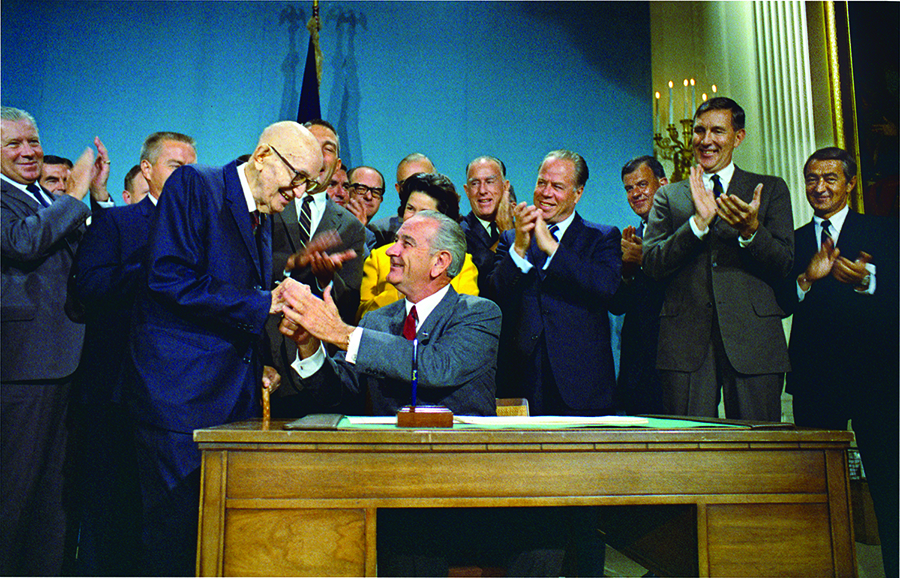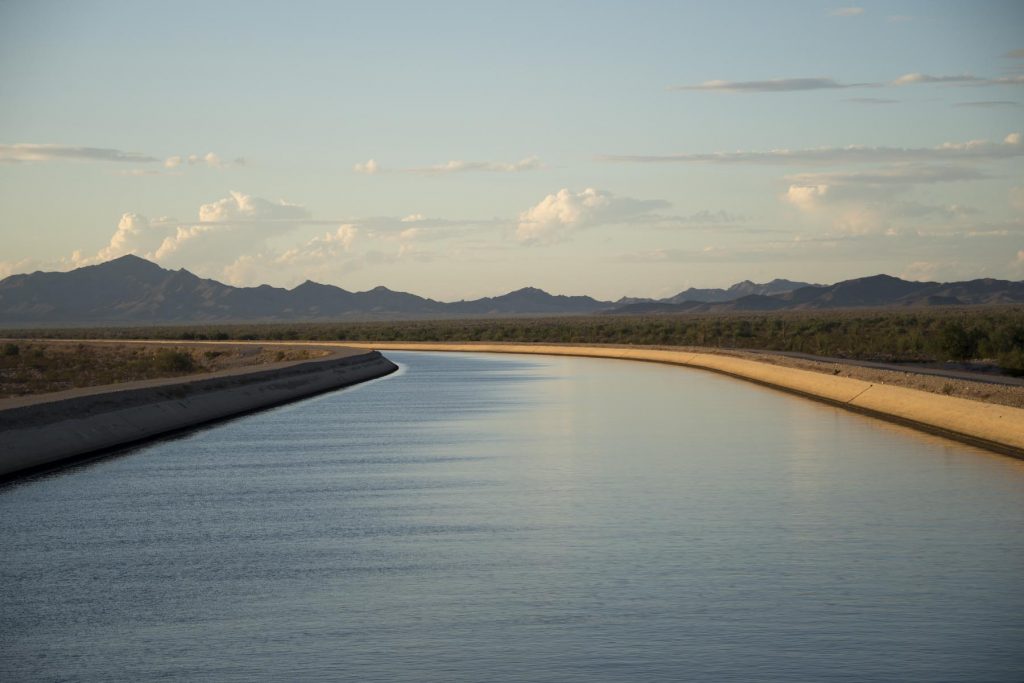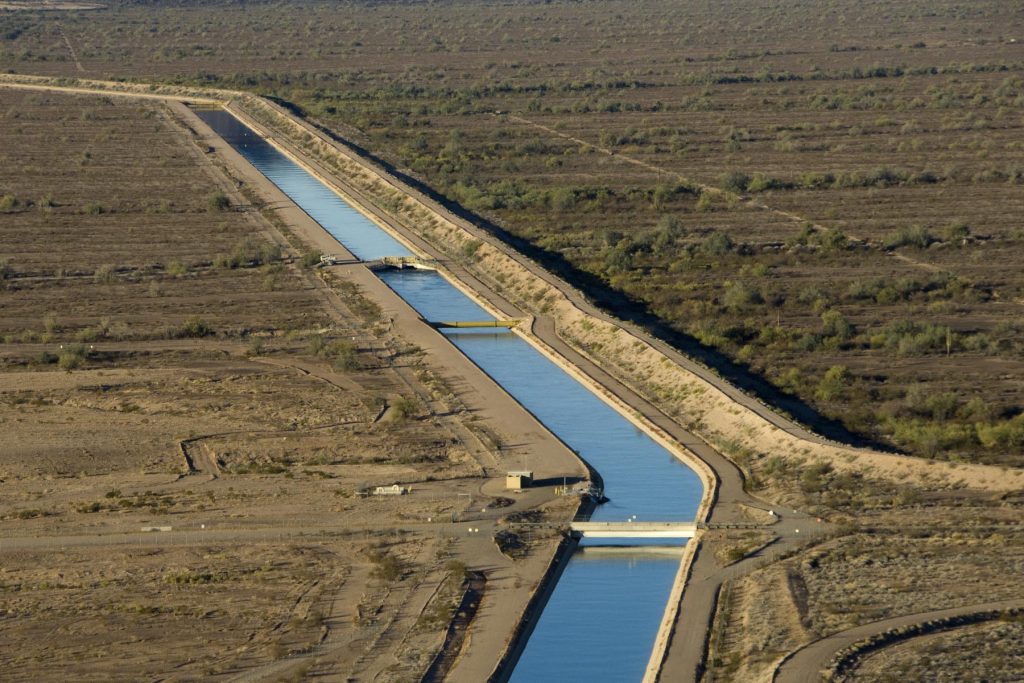On September 30, 1968, President Lyndon B. Johnson, signed into law the Colorado River Basin Project Act.
Fifty years is a long time, especially to those who have lived that long, but to understand the impact of the Colorado River Basin Project Act, I actually think you need to look back even further to a story that began almost exactly 100 years ago.
It took five years to put together the Colorado River Compact of 1922 that allocated 7.5 million acre-feet each to the Upper and Lower Basins of the Colorado River. The specific allocations for each state in the Lower Basin were not established until the 1928 Boulder Canyon Project Act and the current specific allotments in the Upper Basin were not established until 1948 by the Upper Colorado River Basin Compact Act. Arizona did not ratify the Compact until 1944. Senators Carl Hayden and Ernest McFarland introduced legislation to authorize the Central Arizona Project three times between 1946 and 1951 but were not successful. Arizona was not finally satisfied with the individual apportionments in the Lower Basin until the 1964 decree in Arizona v. California after 11 years of litigation, which finally paved the way for the Colorado River Basin Project Act.

Milestones achieved in the past 50 years
In the 50 years since the Basin Project Act was passed, we have seen many other milestones, including initial funding for CAP, commencement of construction and state authorization of the Central Arizona Water Conservation District in the early 1970s. Obtaining federal appropriations for CAP construction became part of the drive for the establishment of the trail-blazing Arizona Groundwater Management Act and the creation of the Arizona Department of Water Resources in 1980. We saw CAP water deliveries commence in the mid-1980s and completion of the first stage of CAP construction and commencement of repayment to the U.S. in 1993 – that was 25 years ago and still only the half-way point of our 50-year journey since 1968.
Since then, the Central Arizona Groundwater Replenishment District (CAGRD) and Arizona Water Banking Authority have been created. We have constructed several underground storage projects, allowing Arizona to take all of its apportionment off the river consistently since the early 2000s. We completed the Arizona Water Settlements Act in 2004.
Since the onset of drought in the Basin at the beginning of the last decade, the Basin States and the United States created the 2007 Guidelines that established, among other things, the conjunctive management of Lake Powell and Lake Mead. Important minutes to the treaty with Mexico were completed in 2012 and 2017. Other agreements and conservation programs have been put in place that have kept us out of shortage in 2016, 2017, 2018 and 2019. Delivery of Colorado River water through the Central Arizona Project has contributed nearly $2 trillion dollars to the Arizona economy in the last 30 years.
But now, on the 50th anniversary of the legislation that authorized this project, we must do more, as we look forward to the next 50 years and beyond.
Do more? That sounds like a tall order and sometimes is exhausting just to think about it.
Let me illustrate my point with a story. A number of years ago, I was reading a story to my oldest daughter, who must have been about six or seven (and is now 30!), about some of the castles and other magnificent structures in Great Britain. We reached a section about the Tower of London and the fact that it had housed some famous prisoners and is to this day the repository for the British crown jewels. It also referenced the legendary Beefeaters, the yeoman warders, and guardians of the Tower. The story read “the Beefeaters have been guarding the Tower of London for over 500 years.” My daughter said, “They must be really, really tired!” I feel that way sometimes, too!
Speaking of magnificent structures and crown jewels…
Every time I drive through the gates at Central Arizona Project … every time I see the CAP aqueduct from the air … every time I visit one of the CAP pumping plants or other facilities … I am struck by the enormity of both the blessing and the responsibility we have inherited. I know that each and every one of our CAP employees relishes the opportunity to work at this special place and be a part of making history every day.
We do not possess this incredible project any more than our predecessors did. We only get to borrow it for a little while, and pass it along to future generations, with the grave responsibility to maintain it during our brief tenure to serve those future generations as well as it has served us.

But our term as custodians must go far beyond some sort of passive preservation function. If we are to come even close to the accomplishments of our predecessors during the last 50 years and the 50 years before that, during the next few years, the next decade and the next half century, we must not only preserve but greatly enhance the utility of this project. This includes not only the physical infrastructure itself, but also the sustainability and reliability of its primary water supply, the Colorado River, the utilization of the infrastructure for expanded purposes, and the legal and contractual infrastructure necessary to support these endeavors.
We must, in order to deal with the ongoing drought and to reverse the erosion of the effectiveness of the 2007 Guidelines as a result of that drought, complete the Drought Contingency Plan or DCP by the end of this year. We must capitalize on the opportunity to join with California, Nevada, Mexico, and the Upper Basin to address the impacts of drought on the river we share.
- We must expand the work to develop additional water supplies through efforts like the Binational Desalination Work Group under minute 323 to the treaty with Mexico.
- We must bring to full fruition the System Use Agreement of 2017, which puts into place for the first time the governance for introduction and transport of non-project water through the CAP system, and which I believe will become one of the legacy accomplishments of the 21st Century in the world of Arizona water.
- And we must commit, during reconsultation under the 2007 guidelines — which will begin in the next 18 months — to make additional progress in addressing the structural deficit.
There are many more things we must do, but this short list provides an example of the challenges that face us in the near term. It will take each of us to make these things happen.
My goal is nothing less than to have Arizonans 50 years from now look back on what we have done during our tenure and judge that our accomplishments are in the same league as those leaders who have come before us. The accomplishments of our predecessors set the bar for these endeavors, and so do their words.
As we look forward to the next 50 years, let us pause to a quote from Senator Carl Hayden on the occasion of another 50th anniversary, that of Arizona statehood:
“I hope to see the day when central Arizona and other important areas of the state have the water required to continue the pattern of growth and progress attained in the first half-century…”
That’s my wish as well.
 This article originally appeared on September 26, 2018, and is being reprinted with permission. The author of this article, Ted Cooke, is the general manager of CAP (Central Arizona Project), one of 20 Water – Use It Wisely partners to offer water-saving advice and programs.
This article originally appeared on September 26, 2018, and is being reprinted with permission. The author of this article, Ted Cooke, is the general manager of CAP (Central Arizona Project), one of 20 Water – Use It Wisely partners to offer water-saving advice and programs.


